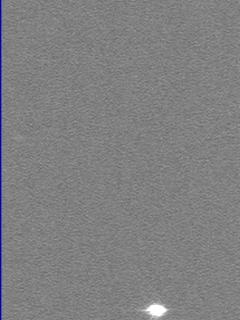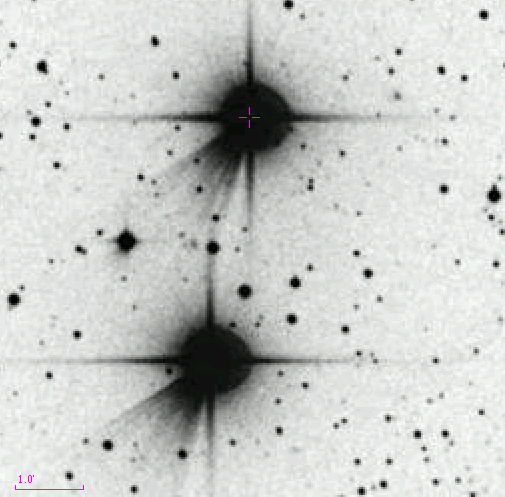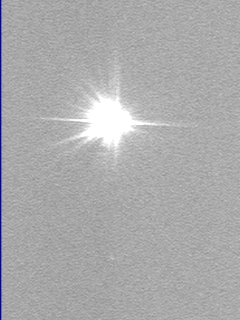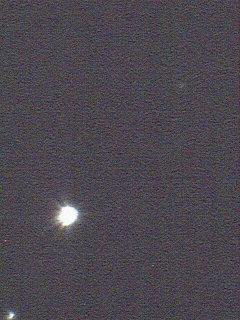
The RIT Observatory's 16-inch f/15 Cassegrain telescope has such a long focal length that it yields a tiny field of view for ordinary cameras (as part I and part II of this series show). I wanted to try taking pictures with a focal reducer in place, since it would increase the field size and perhaps detect fainter stars, too. I pulled out an old Celestron f/6.3 focal reducer, which is designed to take f/10 Schmidt-Cassegrains down to f/6.3.
The cameras:
As you will see, I was able (barely) to find a configuration of the PC164C and focal reducer which brought light to focus, but could not find the right combination of adapters to use the focal reducer with the ToUCam.
Unlike previous tests, this one was not plagued by moonlight. However, there was a moderately thick layer of cirrus which came and went during the PC164C tests; it cleared up for the ToUCam tests. It became obvious that the 16-inch telescope needs collimation :-(
It took me some time to find a combination of adapters which would permit me to focus the PC164C; I had to move the camera as close to the back of the telescope as possible. One of the early images shows that the PC164C has a couple of bits of dust or junk on its detector:

I used an inexpensive video capture card to digitize the video signal and save it to disk. I operated in a binned mode all night, so that images are 320-by-240 pixels.
After a lot of work -- pointing the telescope accurately enough to acquire a target with this small field is hard work! -- I achieved some success in Lyra. Here's an image showing the southern components of epsilon Lyrae and a faint star to their northeast; I've rotated the image so that North is at the top and East to the left to match the conventional orientation.

Here's a closeup of a DSS image of the area. The northern component of the double-double fell just outside the field of view. The fact that I couldn't get both components into the field simultaneously tells me that the field is a bit less than 3.5 arcminutes wide.

The star to the left of the line joining the pair -- the brightest star in the chart other than epsilon Lyrae itself -- has magnitudes Vt = 10.43 (from Tycho) and B = 11.2, R = 11.5, I = 11.8 (from USNO-B1.0).
I also looked at Vega, since I'd heard it had a faint companion. I did see two nearby stars, faintly:

Unfortunately, it's hard to find information on these other stars, since Vega tends to ruin measurements of nearby objects. I think that the faint star nearly due south of Vega is about tenth magnitude, but that's not precise.
A much better test is the star beta Lyrae, which has three neaby stars of well measured and differing magnitudes. Look at this image:

Moving counterclockwise from lower left, the companion stars have magnitudes
star Bt Vt --------------------------------- A 6.7 6.7 B 10.3 10.1 C 10.8 10.6 ---------------------------------
There was a bit of cirrus during these measurements, and the telescope wasn't collimated well.
The signal on these stars is very low. I wanted to measure the variation in instrumental magnitude for the faint stars from one frame to the next, but my star-finding software wouldn't pick them up on individual frames until I went way down into the noise. After I coadded eight frames, my software detected the stars well above the noise .... but then I couldn't compare the magnitudes from one frame to the next. Sigh.
Using stars A and B, I derive a plate scale of 0.535 arcsec per pixel and an overall field size of 171 x 128 arcseonds = 2.85 x 2.14 arcminutes. The ratio of the plate scale with and without the focal reducer is (0.39"/pix) vs. (0.54"/pix) = 0.72 to 1. The focal reducer is designed to take an f/10 telescope to f/6.3, which is roughly consistent with my measurements. Note that I moved the location of the camera closer to the telescope when I included the focal reducer (removing an extension tube about 5 inches long).
My plan was to use the focal reducer with the ToUCam, too, but I discovered that I couldn't find any combination of adapters which would let me connect the focal reducer to the ToUCam. Rats. I'll have to look through some catalogs and see if I can find the right piece. The following tests therefore take place with the ToUCam operating at f/15 Cass focus.
The telescope was still pointing to beta Lyrae, so I took pictures of it with the exposure time set to its maximum value and the gain set to _its_ maximum value (I was using "BTV Carbon Pro" to control the camera on my iBook, and it doesn't provide numerical values for its video settings). I found that I could just fit all four stars into the field. Here's one frame from a movie showing beta Lyrae at the center. North is up, east to the left as usual.

The star B, at magnitude Vt=10.1, is faint but clearly visible. The star C, at magnitude Vt=10.6, is practically invisible in the upper-left corner of this image. If you watch a movie of the frames, however, you can see it peeking faintly above the noise.
I converted the movie into a series of PNG color images, and then used the ImageMagick package to convert color PNG into 8-bit monochrome FITS images. I then used simple aperture photometry to measure the instrumental magnitudes of stars A and B by hand in 10 frames from the beginning of the movie. The difference (B-A) had a mean of 2.16 magnitudes and a scatter of 0.12 magnitudes. That's pretty good for stars so faint (and near the edge of the field, in the case of A).
If we trust the Tycho magnitudes, we can put the limiting magnitude of this combination at about V=10.5.
Putting tonight's results together with those from earlier tests, I now can say that with a 16-inch f/15 cassegrain (which needs collimation),
Camera pixel size field of view limiting mag
(arcseconds) (arcseconds) (very rough)
--------------------------------------------------------------
Astrovid PlanetCam 0.29 94 x 71 6
Astrovid 2000 0.53 168 x 126 8-9
SuperCircuits PC164C 0.39 125 x 94 10-11 (at f/15)
0.54 171 x 128 11-11.5 (at f/10)
ToUCam 0.45 143 x 107 10.5
--------------------------------------------------------------